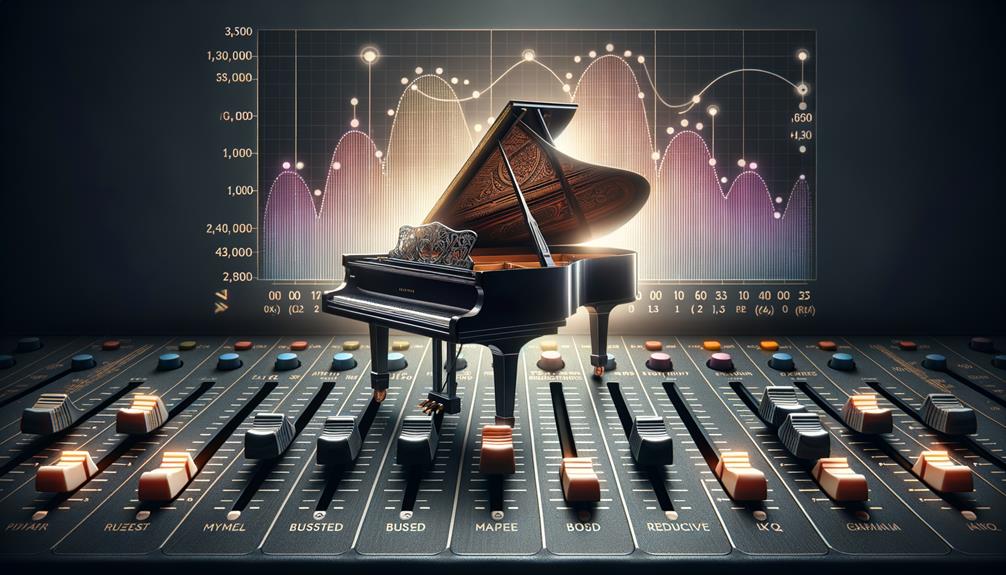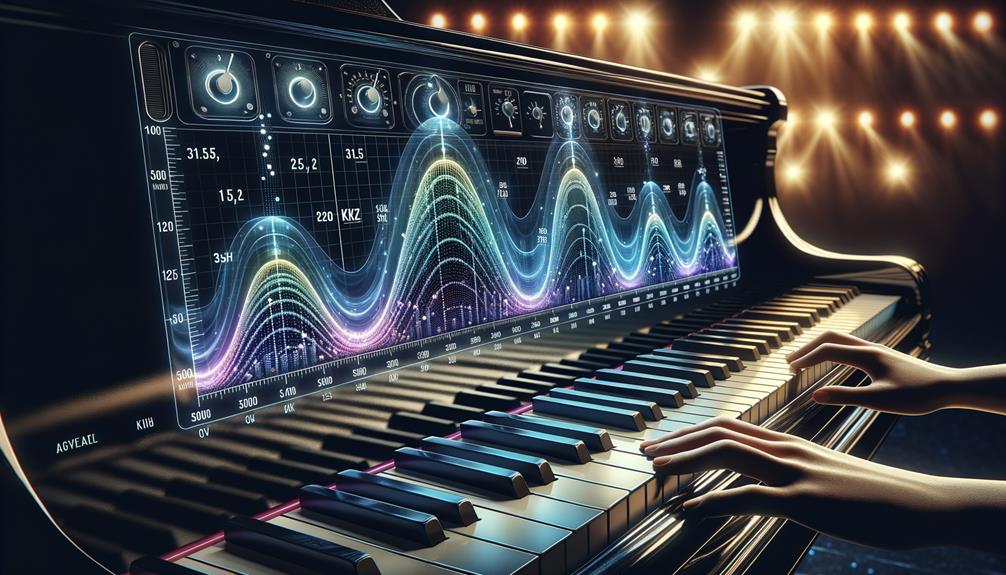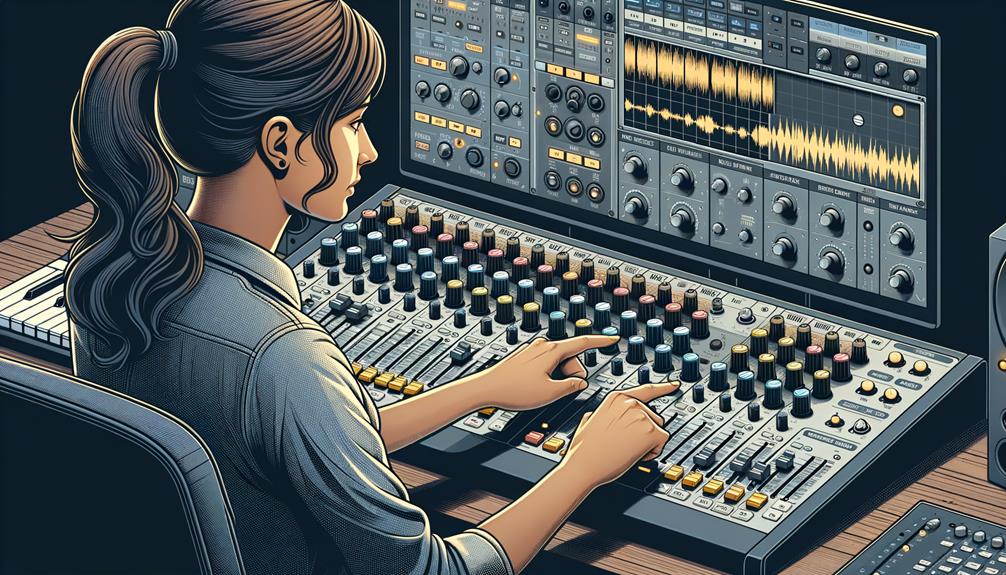Subtotal: £0.00
When it comes to EQing a piano, understanding how to adjust the specific frequency ranges is crucial. Different types of pianos require different EQ settings to achieve the desired sound. Whether it’s a grand, upright, or electronic piano, there’s a whole process to it. It’s not just about adjusting the knobs – it’s about enhancing the power, fullness, clarity, and presence of the piano.
To start, it’s important to understand the piano’s frequency range. Experimenting with presets and personal adjustments can help in finding the perfect EQ that complements the piano in the mix. The goal is to achieve a professional and polished sound.
So, if you’re looking to take your piano sound to the next level, understanding the nuances of EQing is essential. It’s all about finding that perfect EQ that enhances the piano’s sound and brings it to life in the mix.
Key Takeaways
- The piano covers the entire audible frequency spectrum, with lower frequencies contributing to power and fullness, mid-range frequencies affecting muddiness and boxiness, and higher frequencies playing a role in clarity and brilliance.
- Adjusting frequencies can clean up the sound or add brightness to the piano.
- When EQing the piano, it is important to utilize presets and adapt them for the type of piano and octave being used.
- Good equalizer settings include using high pass filters to eliminate rumble and interference, boosting the 75Hz-200Hz range for fullness and warmth, and removing unwanted muddy frequencies while boosting desired content.
Understanding Piano Frequency Range
To effectively manipulate the sound of a piano through EQ, it’s essential to understand the piano’s frequency range and its impact on the instrument’s tone and characteristics. The piano covers the entire audible frequency spectrum, from 20Hz at the low end to 20kHz at the higher notes. Understanding this range is crucial for shaping the piano’s sound in a mix.
For instance, the lower frequencies (20Hz – 200Hz) contribute to the piano’s power and fullness, while the mid-range frequencies (200Hz – 2kHz) affect factors like muddiness, boxiness, and definition. The higher frequencies (2kHz – 20kHz) play a role in the piano’s clarity, presence, air, sparkle, and brilliance.
When using EQ to enhance the piano’s sound, it’s important to consider these frequency ranges. For instance, if the piano sounds muddy, reducing frequencies in the 200Hz – 500Hz range can help to clean up the sound. On the other hand, boosting the higher frequencies can add sparkle and brightness to the piano’s tone.
Familiarizing yourself with the piano’s frequency range and its impact on the sound will enable you to make precise EQ adjustments to achieve the desired tones.
Piano EQing Process
Consider utilizing presets in the Channel EQ plug-in and adapting them to suit the type of piano and octave being played. Start by selecting a preset that closely matches the piano sound you want to achieve.
For example, if the piano has boomy bass notes, adjust the low frequencies to reduce the boominess. Experiment with different presets and make personal adjustments to meet specific EQ needs for the piano.
Keep in mind the pianos frequency range and the notes on the piano. Different frequency ranges can affect the piano’s overall sound, so be attentive to the frequency spectrum.
Take into account the specific frequency ranges to adjust for different qualities like power, clarity, and brilliance in the piano’s sound. Remember to also consider the type of piano being used, whether it’s a grand, upright, or electronic piano, as each has its unique characteristics that require tailored EQ settings.
Good Equalizer Settings


When EQing a piano, utilize high pass filters below 75Hz to eliminate rumble and interference, while boosting the 75Hz-200Hz range to add fullness and warmth to the sound. Experiment with different presets or make personalized adjustments to meet specific needs when EQing your piano.
Consider the type of piano and octave being played before adjusting the EQ settings. When making EQ changes for the piano, consider the overall mix and balance the adjustments based on the specific mix requirements.
Sweep around the 300Hz-600Hz range to identify boxy frequencies and adjust cuts to create a more balanced and pleasing piano tone. It’s crucial to remove unwanted muddy frequencies and boost around the desired frequency content to achieve clear and rich piano sounds.
Creating Vintage Piano Sound
After establishing good equalizer settings for the piano, you can now shift your focus to creating a vintage piano sound by emphasizing warm and rich frequencies typically associated with vintage instruments. Start by boosting the 200Hz-500Hz range using your EQ plug-in to add warmth and fullness to the sound. Consider using Native Instruments or other EQ plug-ins to achieve this.
Additionally, utilize tape saturation or analog emulation plugins to infuse character and warmth into the piano sound, reminiscent of vintage recordings. Experiment with subtle, vintage-style reverb and delay effects to create a sense of space and depth, enhancing the nostalgic feel of the piano.
Roll off some of the extreme highs and lows using EQ to mimic the sonic characteristics of older recordings and vintage equipment. Lastly, incorporate slight detuning or pitch modulation effects to impart a slightly imperfect, aged quality to the piano sound, reflecting the natural inconsistencies found in vintage instruments.
Using EQ Guides


To effectively utilize EQ guides when equalizing a piano, it’s important to understand how specific frequency adjustments can enhance the instrument’s tonal characteristics and overall mix.
When considering the best piano, take into account the type of piano and the octave range being used.
For instance, if you’re working with a bright and clear piano sound, it’s recommended to use EQ to boost around the 2kHz to 5kHz range to enhance clarity and presence.
Conversely, if the piano has a muddier or boxy sound, consider using EQ to cut frequencies in the 200Hz to 500Hz range.
One of the important things to remember when using your ears to make EQ adjustments is to focus on what makes the piano sound good in the mix.
Keep in mind the type of piano being used and how the piano was recorded, as this will impact the EQ adjustments needed to achieve the desired tonal characteristics.
Frequently Asked Questions
How Do You Do EQ on a Piano?
To EQ a piano, adjust specific frequency ranges for power, fullness, definition, presence, and brilliance. Experiment with presets in the Channel EQ plug-in and make personal adjustments based on the piano type and characteristics.
What Are the EQ Settings for Piano Music?
For piano music, adjust frequency ranges to balance instrument, shape tone, and enhance clarity. Consider dynamic range, room acoustics, and piano timbre. Use EQ techniques to address mixing challenges and achieve instrumental clarity.
How Do You Make a Piano Sound Good in a Mix?
To make a piano sound good in a mix, adjust the piano frequency, dynamics, and timbre using EQ techniques. Sculpt the piano’s presence and resonance, making EQ adjustments to achieve a balanced mix.
Where Should Piano Sit in a Mix?
In a mix, the piano should sit in a balanced frequency range, complementing vocals and other instruments. Integrate it with the drum, guitar, and bass levels, using reverb, compression, and EQ automation for optimal integration and clarity.
Conclusion
Now that you understand the piano frequency range and the EQing process, you can use good equalizer settings to enhance the power, fullness, and clarity of the piano.
Experiment with vintage piano sounds and use EQ guides to perfect your piano EQ.
Consider factors like room acoustics and microphone placement for the overall mix.
With practice and personal adjustments, you can achieve the perfect EQ for any type of piano.





